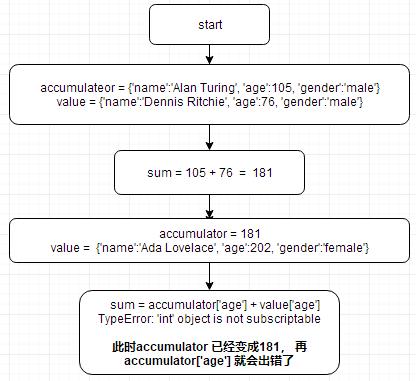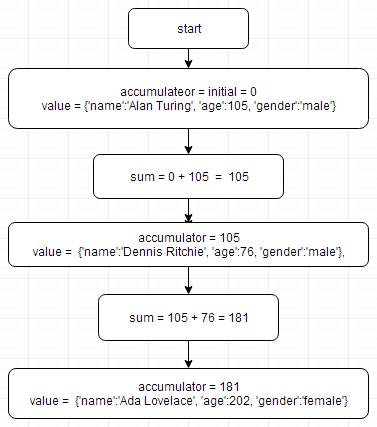弄明白python reduce 函数
Posted lonkiss
tags:
篇首语:本文由小常识网(cha138.com)小编为大家整理,主要介绍了弄明白python reduce 函数相关的知识,希望对你有一定的参考价值。
作者:Panda Fang
出处:http://www.cnblogs.com/lonkiss/p/understanding-python-reduce-function.html
原创文章,转载请注明作者和出处,未经允许不可用于商业营利活动
reduce() 函数在 python 2 是内置函数, 从python 3 开始移到了 functools 模块。
官方文档是这样介绍的
reduce(...)
reduce(function, sequence[, initial]) -> valueApply a function of two arguments cumulatively to the items of a sequence,
from left to right, so as to reduce the sequence to a single value.
For example, reduce(lambda x, y: x+y, [1, 2, 3, 4, 5]) calculates
((((1+2)+3)+4)+5). If initial is present, it is placed before the items
of the sequence in the calculation, and serves as a default when the
sequence is empty.从左到右对一个序列的项累计地应用有两个参数的函数,以此合并序列到一个单一值。
例如,reduce(lambda x, y: x+y, [1, 2, 3, 4, 5]) 计算的就是((((1+2)+3)+4)+5)。
如果提供了 initial 参数,计算时它将被放在序列的所有项前面,如果序列是空的,它也就是计算的默认结果值了
嗯, 这个文档其实不好理解。看了还是不懂。 序列 其实就是python中 tuple list dictionary string 以及其他可迭代物,别的编程语言可能有数组。
reduce 有 三个参数
| function | 有两个参数的函数, 必需参数 |
| sequence | tuple ,list ,dictionary, string等可迭代物,必需参数 |
| initial | 初始值, 可选参数 |
reduce的工作过程是 :在迭代sequence(tuple ,list ,dictionary, string等可迭代物)的过程中,首先把 前两个元素传给 函数参数,函数加工后,然后把得到的结果和第三个元素作为两个参数传给函数参数, 函数加工后得到的结果又和第四个元素作为两个参数传给函数参数,依次类推。 如果传入了 initial 值, 那么首先传的就不是 sequence 的第一个和第二个元素,而是 initial值和 第一个元素。经过这样的累计计算之后合并序列到一个单一返回值
reduce 代码举例,使用REPL演示
>>> def add(x, y): ... return x+y ... >>> from functools import reduce >>> reduce(add, [1,2,3,4]) 10 >>>
>>> sum([1,2,3,4])
10
>>>
很多教程只讲了一个加法求和,太简单了,对新手加深理解还不够。下面讲点更深入的例子
还可以把一个整数列表拼成整数,如下
>>> from functools import reduce >>> reduce(lambda x, y: x * 10 + y, [1 , 2, 3, 4, 5]) 12345 >>>
对一个复杂的sequence使用reduce ,看下面代码,更多的代码不再使用REPL, 使用编辑器编写
1 from functools import reduce 2 scientists =({\'name\':\'Alan Turing\', \'age\':105}, 3 {\'name\':\'Dennis Ritchie\', \'age\':76}, 4 {\'name\':\'John von Neumann\', \'age\':114}, 5 {\'name\':\'Guido van Rossum\', \'age\':61}) 6 def reducer(accumulator , value): 7 sum = accumulator[\'age\'] + value[\'age\'] 8 return sum 9 total_age = reduce(reducer, scientists) 10 print(total_age)

1 from functools import reduce 2 scientists =({\'name\':\'Alan Turing\', \'age\':105, \'gender\':\'male\'}, 3 {\'name\':\'Dennis Ritchie\', \'age\':76, \'gender\':\'male\'}, 4 {\'name\':\'Ada Lovelace\', \'age\':202, \'gender\':\'female\'}, 5 {\'name\':\'Frances E. Allen\', \'age\':84, \'gender\':\'female\'}) 6 def reducer(accumulator , value): 7 sum = accumulator + value[\'age\'] 8 return sum 9 total_age = reduce(reducer, scientists, 0) 10 print(total_age)

这个仍然也可以用 sum 来更简单的完成
sum([x[\'age\'] for x in scientists ])
做点更高级的事情,按性别分组
from functools import reduce scientists =({\'name\':\'Alan Turing\', \'age\':105, \'gender\':\'male\'}, {\'name\':\'Dennis Ritchie\', \'age\':76, \'gender\':\'male\'}, {\'name\':\'Ada Lovelace\', \'age\':202, \'gender\':\'female\'}, {\'name\':\'Frances E. Allen\', \'age\':84, \'gender\':\'female\'}) def group_by_gender(accumulator , value): accumulator[value[\'gender\']].append(value[\'name\']) return accumulator grouped = reduce(group_by_gender, scientists, {\'male\':[], \'female\':[]}) print(grouped)
输出
{\'male\': [\'Alan Turing\', \'Dennis Ritchie\'], \'female\': [\'Ada Lovelace\', \'Frances E. Allen\']}
grouped = reduce(group_by_gender, scientists, collections.defaultdict(list))
当然 先要 import collections 模块
这当然也能用 pythonic way 去解决
import itertools scientists =({\'name\':\'Alan Turing\', \'age\':105, \'gender\':\'male\'}, {\'name\':\'Dennis Ritchie\', \'age\':76, \'gender\':\'male\'}, {\'name\':\'Ada Lovelace\', \'age\':202, \'gender\':\'female\'}, {\'name\':\'Frances E. Allen\', \'age\':84, \'gender\':\'female\'}) grouped = {item[0]:list(item[1]) for item in itertools.groupby(scientists, lambda x: x[\'gender\'])} print(grouped)
再来一个更晦涩难懂的玩法。工作中要与其他人协作的话,不建议这么用,与上面的例子做同样的事,看不懂无所谓。
from functools import reduce scientists =({\'name\':\'Alan Turing\', \'age\':105, \'gender\':\'male\'}, {\'name\':\'Dennis Ritchie\', \'age\':76, \'gender\':\'male\'}, {\'name\':\'Ada Lovelace\', \'age\':202, \'gender\':\'female\'}, {\'name\':\'Frances E. Allen\', \'age\':84, \'gender\':\'female\'}) grouped = reduce(lambda acc, val: {**acc, **{val[\'gender\']: acc[val[\'gender\']]+ [val[\'name\']]}}, scientists, {\'male\':[], \'female\':[]}) print(grouped)
**acc, **{val[\'gneder\']... 这里使用了 dictionary merge syntax , 从 python 3.5 开始引入, 详情请看 PEP 448 - Additional Unpacking Generalizations 怎么使用可以参考这个 python - How to merge two dictionaries in a single expression? - Stack Overflow
以上是关于弄明白python reduce 函数的主要内容,如果未能解决你的问题,请参考以下文章